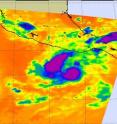NASA infrared imagery hinted Darby would become a hurricane
Infrared imagery provides forecasters with a look at the temperature of cloud tops in tropical cyclones, sea surface and land surface temperatures and more. NASA infrared imagery from the morning of June 24 revealed that Darby had strong convection that is an indicator of a strengthening storm. Tropical Storm Darby became the second hurricane of the Eastern Pacific Ocean season this morning. When NASA's Aqua satellite flew over Darby on June 24 at 08:23 UTC (4:23 a.m. EDT), the Atmospheric Infrared Sounder (AIRS) instrument onboard the satellite captured an infrared image of Darby's clouds, hours before it achieved hurricane status. The infrared imagery showed very high, cold thunderstorm cloud tops in the southeast and northern quadrants of the storm indicating strong convection. Convection is rapidly rising air the condenses and forms clouds (and in a tropical cyclone, it forms the thunderstorms that power the cyclone).
At 11 a.m. EDT (8 a.m. PDT) on June 24, the National Hurricane Center announced that Darby achieved hurricane status, making it the second hurricane of the Eastern Pacific Ocean season, just after Celia, which is spinning at sea much farther west. Hurricane Darby has maximum sustained winds near 75 mph, making it a category one hurricane on the Saffir-Simpson scale. (Category one hurricanes begin at 74 mph). Darby is located about 235 miles (375 km) south-southwest of Puerto Escondido, Mexico, near 12.8 North and 98.7 West. Darby is moving west near 9 mph (15 km/hr) and has a minimum central pressure near 990 millibars.
The National Hurricane Center forecasters expect vertical wind shear (winds that can tear a tropical cyclone apart) to remain light, so there's an opportunity for Darby to strengthen a little over the next couple of days before the winds increase.
Source: NASA/Goddard Space Flight Center
Articles on the same topic
- NASA's infrared satellite imagery sees Tropical Storm Darby form quicklyWed, 23 Jun 2010, 19:03:46 UTC
- NASA's Aqua and Terra satellites view Tropical Storms Blas and CeliaMon, 21 Jun 2010, 19:08:02 UTC
- NASA's TRMM Satellite sees Tropical Depression 2-E dissipatingFri, 18 Jun 2010, 20:03:48 UTC
- Tropical Storm Blas bearing bouts of strong convection in NASA imageryFri, 18 Jun 2010, 20:03:47 UTC
- Tropical Depression 2-E struggling, while Tropical Storm Blas is bornThu, 17 Jun 2010, 20:13:58 UTC
- Tropical Depression 2-E forms in the Eastern Pacific, number 3 may followWed, 16 Jun 2010, 21:04:11 UTC
Other sources
- NASA infrared imagery hinted Darby would become a hurricanefrom Science BlogThu, 24 Jun 2010, 22:01:04 UTC
- NASA infrared imagery hinted Darby would become a hurricanefrom PhysorgThu, 24 Jun 2010, 21:30:41 UTC
- NASA’s infrared satellite imagery sees Tropical Storm Darby form quicklyfrom Science BlogWed, 23 Jun 2010, 21:02:36 UTC
- Aqua infrared satellite imagery sees Tropical Storm Darby form quicklyfrom PhysorgWed, 23 Jun 2010, 20:30:27 UTC
- NASA’s Aqua and Terra satellites view Tropical Storms Blas and Celiafrom Science BlogMon, 21 Jun 2010, 19:30:20 UTC
- NASA's Aqua and Terra satellites view Tropical Storms Blas and Celiafrom PhysorgMon, 21 Jun 2010, 19:01:36 UTC
- NASA's TRMM Satellite sees Tropical Depression 2-E dissipatingfrom PhysorgFri, 18 Jun 2010, 21:30:58 UTC
- Tropical Storm Blas bearing bouts of strong convection in NASA imageryfrom PhysorgFri, 18 Jun 2010, 21:30:51 UTC
- Tropical Storm Blas bearing bouts of strong convection in NASA imageryfrom Science BlogFri, 18 Jun 2010, 20:30:40 UTC
- NASA’s TRMM Satellite sees Tropical Depression 2-E dissipatingfrom Science BlogFri, 18 Jun 2010, 20:30:39 UTC
- Tropical Depression 2-E struggling, while Tropical Storm Blas is bornfrom Science BlogThu, 17 Jun 2010, 20:50:18 UTC
- Tropical Depression 2-E struggling, while Tropical Storm Blas is bornfrom PhysorgThu, 17 Jun 2010, 20:20:19 UTC
- Tropical Depression 2-E forms in the Eastern Pacific, number 3 may followfrom Science BlogWed, 16 Jun 2010, 22:31:46 UTC
- Tropical Depression 2-E forms in the Eastern Pacific, number 3 may followfrom PhysorgWed, 16 Jun 2010, 21:00:56 UTC

